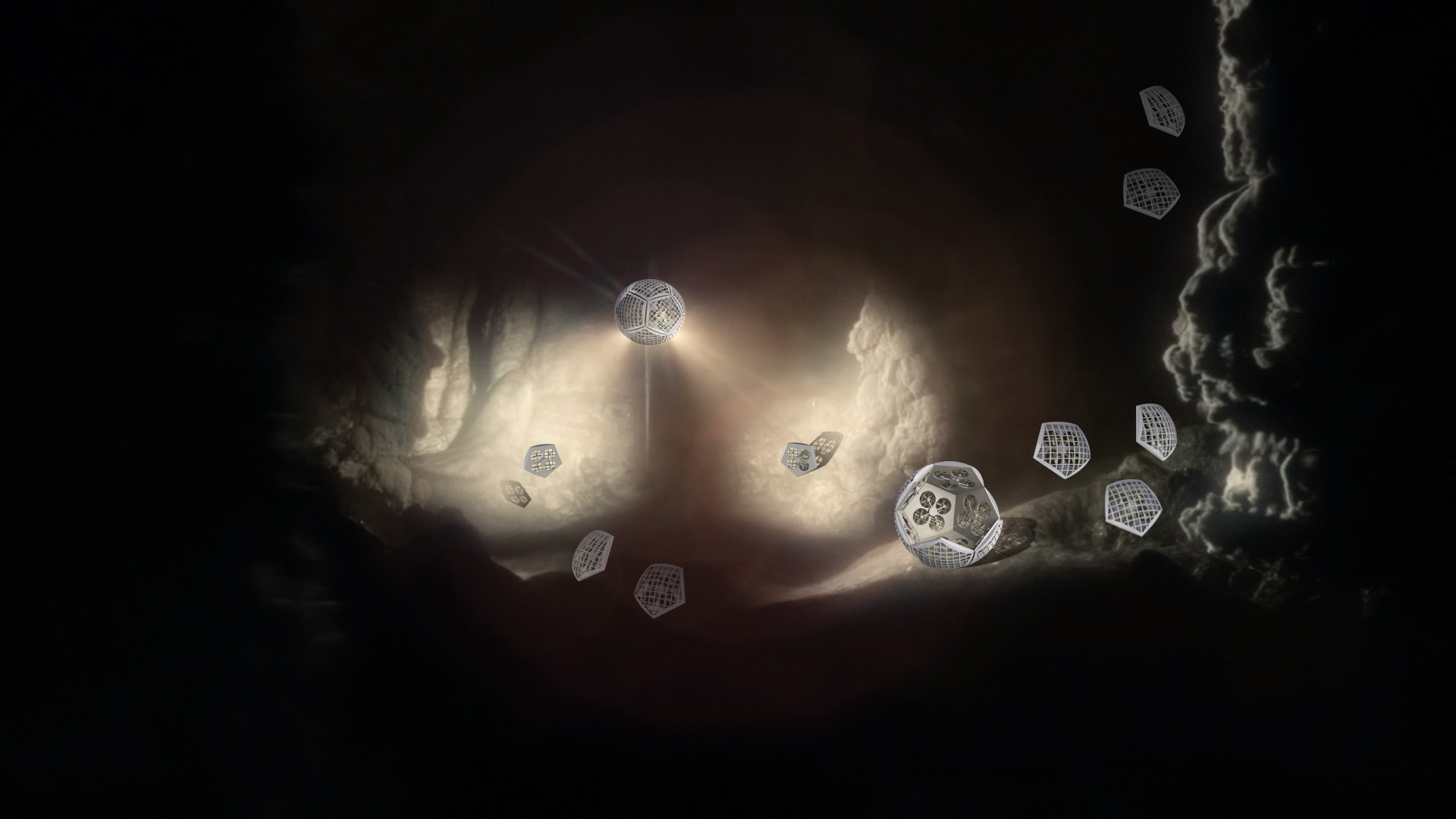Shape-Shifting Robots on Titan and 24 Other Wild Tech Ideas Have Caught NASA's Eye

A futuristic space-exploration proposal from NASA would see shape-shifting robots roaming the surface or atmosphere of the soupy Saturn moon Titan, which may host a precursor to the chemistry of life.
The flying, amphibious robot, called Shapeshifter — one of 25 NASA-funded proposals — could be used to cruise through Titan's atmosphere, go spelunking in caves or dive into the moon's many seas.
"Shapeshifter can morph into a ball that rolls on the surface, a flight array that can fly and hover above-surface and move in subsurface voids, and a torpedo-like structure to swim under liquid efficiently, among other mobility modes," NASA officials wrote in a statement. [Incredible Technology for Space Exploration]
Shapeshifter is one of 25 early-stage technology proposals selected in the 2018 round of NASA's Innovative Advanced Concepts (NIAC) Phase 1 concepts. Other proposals include space telescope swarms and meteoroid impact detection. Each of the proposals is valued at approximately $125,000. Investigators have nine months to work on the definition and analysis of the concepts.
At the end of the process, the teams can apply for Phase 2 awards. These are valued at up to $500,000 for two years of study. This year's NIAC selection includes nine Phase 2 proposals, which range from interstellar precursor missions, to a huge space telescope, to an exploration concept for an icy Neptune moon called Triton.
In general, NIAC proposals are considered very early stage, years or decades away from a mission flight — if they remain of interest for long enough. But their work provides a library of concepts from which NASA can draw during mission development, the agency said.
"The NIAC program gives NASA the opportunity to explore visionary ideas that could transform future NASA missions by creating radically better or entirely new concepts while engaging America's innovators and entrepreneurs as partners in the journey," Jim Reuter, acting associate administrator of NASA's Space Technology Mission Directorate, said in the NASA statement. "The concepts can then be evaluated for potential inclusion into our early stage technology portfolio."
Breaking space news, the latest updates on rocket launches, skywatching events and more!
The full list of NIAC Phase 1 recipients is:
- Shapeshifters from Science Fiction to Science Fact: Globetrotting from Titan's Rugged Cliffs to its Deep Seafloors (Ali-akbar Agha-mohammadi, NASA's Jet Propulsion Laboratory (JPL), Pasadena, California)
- Biobot: Innovative Offloading of Astronauts for More Effective Exploration (David Akin, University of Maryland, College Park)
- Lofted Environmental and Atmospheric Venus Sensors (LEAVES) (Jeffrey Balcerski, Ohio Aerospace Institute, Cleveland)
- Meteoroid Impact Detection for Exploration of Asteroids (MIDEA) (Sigrid Close, Stanford University, California)
- On-Orbit, Collision-Free Mapping of Small Orbital Debris (Christine Hartzell, University of Maryland, College Park)
- Marsbee – Swarm of Flapping Wing Flyers for Enhanced Mars Exploration (Chang-kwon Kang, University of Alabama in Huntsville)
- Rotary Motion Extended Array Synthesis (R-MXAS) (John Kendra, Leidos Inc., Reston, Virginia)
- PROCSIMA: Diffractionless Beamed Propulsion for Breakthrough Interstellar Missions (Chris Limbach, Texas A&M Engineering Experiment Station, College Station)
- SPARROW: Steam Propelled Autonomous Retrieval Robot for Ocean Worlds (Gareth Meirion-Griffith, JPL)
- BALLET: Balloon Locomotion for Extreme Terrain (Hari Nayar, JPL)
- Myco-Architecture off Planet: Growing Surface Structures at Destination (Lynn Rothschild, NASA's Ames Research Center, Moffett Field, California)
- Modular Active Self-Assembling Space Telescope Swarms (Dmitry Savransky, Cornell University, Ithaca, New York)
- Astrophysics and Technical Study of a Solar Neutrino Spacecraft (Nickolas Solomey, Wichita State University, Kansas)
- Advanced Diffractive MetaFilm Sailcraft (Grover Swartzlander, Rochester Institute of Technology, New York)
- Spectrally Resolved Synthetic Imaging Interferometer (Jordan Wachs, Ball Aerospace & Technologies Corporation, Boulder, Colorado)
- Radioisotope Positron Propulsion (Ryan Weed, Positron Dynamics, Livermore, California)
The full list of NIAC Phase 2 recipients is:
- Pulsed Fission-Fusion (PuFF) Propulsion Concept (Robert Adams, NASA's Marshall Space Flight Center, Huntsville, Alabama)
- A Breakthrough Propulsion Architecture for Interstellar Precursor Missions (John Brophy, JPL)
- Kilometer Space Telescope (KST) (Devon Crowe, Raytheon, El Segundo, California)
- Dismantling Rubble Pile Asteroids with AoES (Area-of-Effect Soft-bots) (Jay McMahon, University of Colorado Boulder)
- Triton Hopper: Exploring Neptune's Captured Kuiper Belt Object (Steven Oleson, NASA's Glenn Research Center, Cleveland)
- Spacecraft Scale Magnetospheric Protection from Galactic Cosmic Radiation (John Slough, MSNW, LLC, Redmond, Washington)
- Direct Multipixel Imaging and Spectroscopy of an Exoplanet with a Solar Gravity Lens Mission (Slava Turyshev, JPL)
- NIMPH: Nano Icy Moons Propellant Harvester (Michael VanWoerkom, ExoTerra Resource, Littleton, Colorado)
- Mach Effect for In-Space Propulsion: Interstellar Mission (James Woodward, Space Studies Institute Inc., Mojave, California)
Follow us @Spacedotcom, Facebook and Google+. Original article on Space.com.

Elizabeth Howell (she/her), Ph.D., was a staff writer in the spaceflight channel between 2022 and 2024 specializing in Canadian space news. She was contributing writer for Space.com for 10 years from 2012 to 2024. Elizabeth's reporting includes multiple exclusives with the White House, leading world coverage about a lost-and-found space tomato on the International Space Station, witnessing five human spaceflight launches on two continents, flying parabolic, working inside a spacesuit, and participating in a simulated Mars mission. Her latest book, "Why Am I Taller?" (ECW Press, 2022) is co-written with astronaut Dave Williams.
